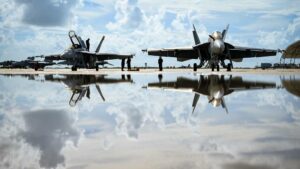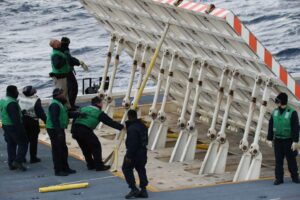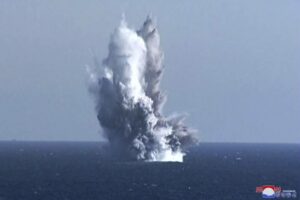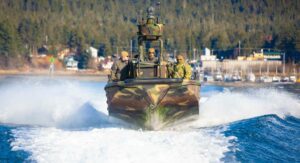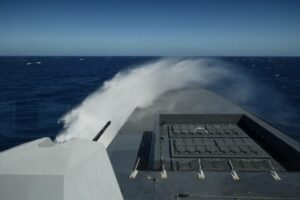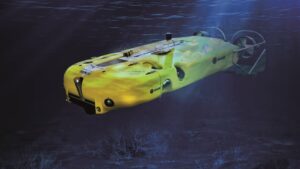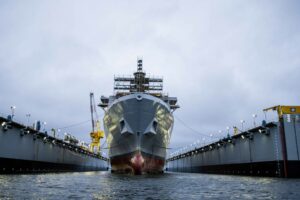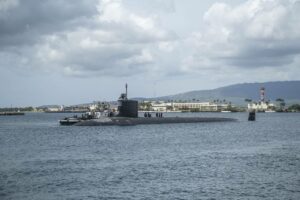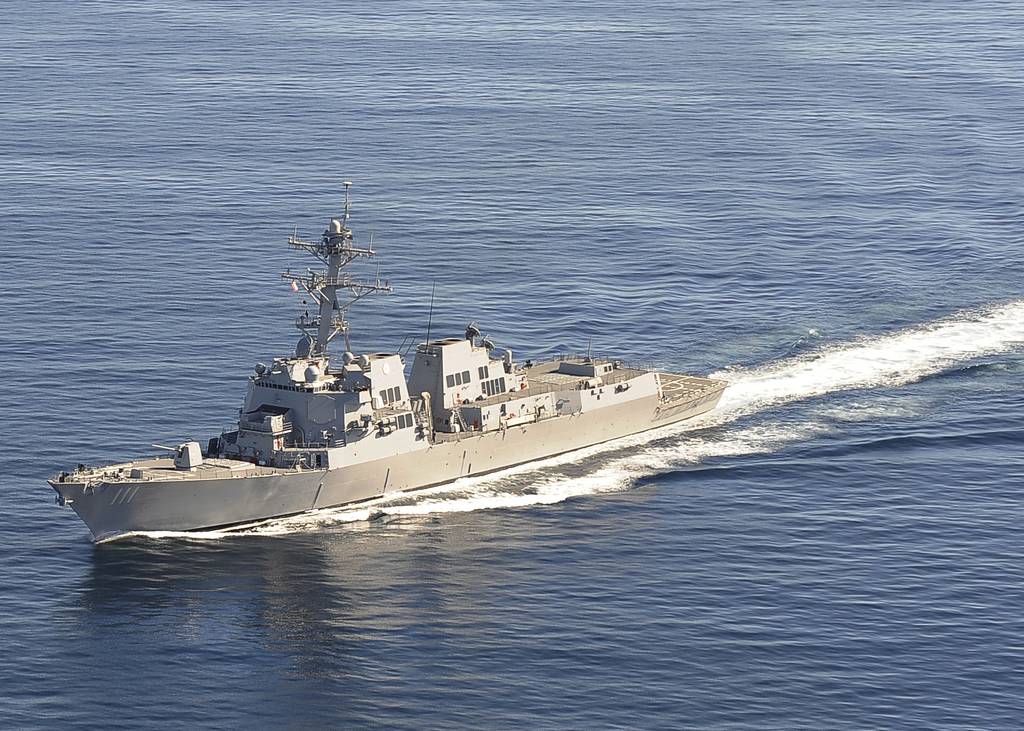
Last month in Washington, leaders from Japan, South Korea and the United States gathered to “inaugurate a new era of trilateral partnership.” Such alignment, they declared, would be necessary to generate “the common capacity required to ensure that the Indo-Pacific is thriving, connected, resilient, stable, and secure.”
As an instrument of national power, naval military capacity is important because it deters potential aggressors and is a prescient indicator of victory in a war at sea. However, U.S. defense-industrial base constraints complicate unilateral capacity-building efforts. Despite unprecedented bipartisan budgetary support for shipbuilding, domestic producers have struggled to keep pace with Navy requirements.
Overcoming these challenges requires an ambitious approach. One alternative is to reduce or eliminate ships’ upkeep periods to extend operational windows, though doing so compounds future maintenance bills. A better one is to capitalize on our collective strengths and leverage our allies’ production resources while continuing to build at home.
Consequently, Japan, South Korea and the U.S. should mirror the AUKUS framework between Australia, the United Kingdom and the U.S. to create a multinational guided-missile destroyer construction program.
Japan and South Korea — the latter also known as the Republic of Korea, or ROK — have thriving shipbuilding industries that manufacture commercial vessels but also guided-missile destroyers, known by their naval designator DDG — and for less money than the American variant I commanded.
Enter AUKUS’ paradigm-shifting approach, in which the three nations will contribute to a new class of attack submarines — termed SSN-AUKUS — that is rooted in a U.K. design, incorporates technologies from the three partner nations, and will be built by both Australia and the U.K. Ultimately this will increase combined capacity by embracing commonality and leveraging all three nations’ industrial bases.
For “DDG-JROKUS” to work, all three nations would have to agree to a standardized ship design. In theory, this should not be contentious because modern Japanese and South Korean destroyers already share American phased array radars, combat systems, vertically launched missiles and even silhouettes.
There are several ways in which a combined DDG-JROKUS shipbuilding program could be implemented:
- Each country could independently and simultaneously manufacture an entire ship.
- Countries could specialize in different phases of construction.
- Companies could band together in a teaming approach to assemble a single hull.
Regardless, collaborative production offers myriad benefits while demonstrating that improving capability and capacity need not be mutually exclusive.
First, DDG-JROKUS would overcome domestic industrial base constraints to grow the size of the fleet — especially important considering the oldest American destroyers will begin to decommission in the early 2030s. Such a dire need exists to grow the U.S. surface force that the question should not be whether we build here or there, but how to build here and there.
Second, DDG-JROKUS would enhance tactical flexibility. While deployed, I sailed alongside ships from the Japan Maritime Self-Defense Force and the South Korean Navy, and I can attest to their competence and professionalism. But there is no denying that operating a common platform would better position us to train and fight together at sea. This also creates efficiencies in repairing, replenishing and rearming ships, which will improve fleet endurance far from home.
Third, a combined military construction project would strengthen diplomatic ties among the three nations at a critical moment in history, creating the social and political cohesion required to prevail in a protracted conflict.
Lastly, DDG-JROKUS would send a clear geopolitical signal that regional powers in the Indo-Pacific region are aligned in their commitment to maintaining a free and open maritime order. Like AUKUS, the strategic messaging benefits from DDG-JROKUS may be as powerful as the platforms’ firepower.
But before breaking a celebratory bottle of champagne across the bow, obstacles must be addressed.
One barrier are societal attitudes against acquiring U.S. warships from overseas because of America’s proud manufacturing history. While patriotic, other countries have outsourced warship construction and design, just as the U.S. did for the forthcoming Constellation-class frigate.
A second argument is that legal provisions governing export controls, supply restrictions and information sharing would sink such a plan at the pier. But we allow foreign military sales of sensitive technology when the risk justifies the collective reward, just as we did to outfit Japan’s and South Korea’s current destroyers. And we have collaborated with friendly military consortiums before to build common platforms like Joint Strike Fighter aircraft and NATO SeaSparrow missiles.
Importantly, AUKUS is addressing these issues, and the diplomatic, legislative and programmatic solutions can be applied to DDG-JROKUS as well. Unlike AUKUS, a conventional warship program does not involve notoriously secretive nuclear reactor technology, which could accelerate a combined venture.
The complex nature of maritime warfare necessitates tactical and technical partnering with our most capable allies to multiply our combat advantage. Allied warship production can weld American alliances and ensure the Indo-Pacific region remains prosperous for all — now and in the future.
Cmdr. Douglas Robb commanded the U.S. Navy’s guided-missile destroyer Spruance, and is currently a U.S. Navy fellow at the University of Oxford. The opinions expressed in this commentary are those of the author and do not necessarily reflect the views of the U.S. Defense Department.
- SEO Powered Content & PR Distribution. Get Amplified Today.
- PlatoData.Network Vertical Generative Ai. Empower Yourself. Access Here.
- PlatoAiStream. Web3 Intelligence. Knowledge Amplified. Access Here.
- PlatoESG. Carbon, CleanTech, Energy, Environment, Solar, Waste Management. Access Here.
- PlatoHealth. Biotech and Clinical Trials Intelligence. Access Here.
- Source: https://www.defensenews.com/opinion/2023/10/05/japan-south-korea-and-the-us-should-mirror-aukus-for-destroyers/
- :is
- :not
- 70
- a
- accelerate
- acquiring
- across
- addressed
- addressing
- ADvantage
- against
- aircraft
- aligned
- All
- Alliances
- allow
- alongside
- already
- also
- alternative
- ambitious
- American
- among
- an
- and
- applied
- approach
- ARE
- argument
- Array
- AS
- At
- attack
- Australia
- author
- BAND
- barrier
- base
- BE
- because
- before
- begin
- benefits
- Better
- better position
- between
- Bills
- bipartisan
- both
- Breaking
- build
- built
- but
- by
- CAN
- capability
- capable
- Capacity
- capitalize
- challenges
- Champagne
- class
- clear
- CNN
- cohesion
- collaborated
- collaborative
- Collective
- combat
- combined
- Commentary
- commercial
- commitment
- Common
- complex
- conflict
- Congress
- connected
- considering
- constraints
- construction
- continuing
- contribute
- controls
- conventional
- could
- countries
- country
- create
- creates
- Creating
- critical
- Current
- Currently
- Defense
- Defense Department
- demonstrating
- Department
- deployed
- Design
- Despite
- DID
- different
- dire
- do
- does
- doing
- Domestic
- douglas
- Early
- efficiencies
- efforts
- eliminate
- embracing
- enhance
- ensure
- Entire
- Era
- especially
- Even
- Exclusive
- exists
- export
- expressed
- extend
- far
- fellow
- fight
- FLEET
- Flexibility
- For
- Force
- foreign
- forthcoming
- Free
- friendly
- from
- future
- GAO
- generate
- geopolitical
- governing
- Grow
- Have
- here
- history
- Home
- How
- How To
- However
- HTML
- HTTPS
- i
- images
- implemented
- important
- improve
- improving
- in
- incorporates
- Increase
- independently
- Indicator
- industrial
- industries
- information
- instrument
- involve
- issues
- IT
- Japan
- Japan’s
- Japanese
- joint
- jpg
- just
- Keep
- Kingdom
- known
- korea
- Korea’s
- Korean
- launched
- leaders
- Legislative
- Leverage
- leveraging
- like
- maintaining
- maintenance
- manufacturing
- Maritime
- May..
- messaging
- Military
- mirror
- missiles
- Modern
- moment
- Month
- most
- multinational
- must
- mutually
- myriad
- National
- Nations
- Nature
- necessarily
- necessary
- Need
- New
- no
- now
- nuclear
- obstacles
- of
- Offers
- oldest
- on
- ONE
- open
- operating
- operational
- Opinions
- or
- order
- Other
- our
- Overcome
- overseas
- Oxford
- partner
- partnering
- Partnership
- periods
- Phased
- plan
- platform
- Platforms
- plato
- Plato Data Intelligence
- PlatoData
- political
- position
- potential
- power
- powerful
- powers
- Producers
- Production
- professionalism
- Program
- programmatic
- project
- prosperous
- proud
- question
- reactor
- reduce
- reflect
- region
- regional
- remains
- repairing
- Republic
- required
- Requirements
- requires
- resilient
- Resources
- restrictions
- Reward
- Risk
- rooted
- s
- sales
- SEA
- Second
- secure
- send
- sensitive
- several
- Share
- sharing
- ships
- should
- Signal
- simultaneously
- single
- Size
- So
- Social
- societal
- Solutions
- South
- South Korea
- south korean
- specialize
- stable
- States
- Strategic
- strengths
- strike
- such
- supply
- support
- Surface
- Systems
- tactical
- Technical
- Technologies
- Technology
- than
- that
- The
- The Future
- the United Kingdom
- their
- theory
- There.
- These
- they
- this
- those
- though?
- three
- thriving
- Ties
- to
- together
- Train
- U.K.
- u.s.
- U.S. Navy
- Ultimately
- United
- United Kingdom
- United States
- university
- University of Oxford
- unlike
- unprecedented
- us
- Variant
- venture
- vertically
- vessels
- views
- war
- washington
- ways
- we
- WELL
- when
- whether
- which
- while
- will
- windows
- with
- Work
- would
- zephyrnet

